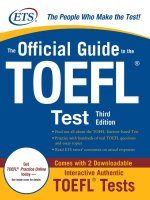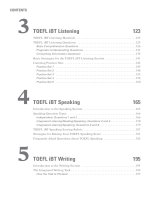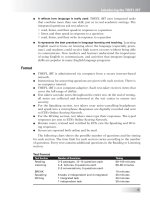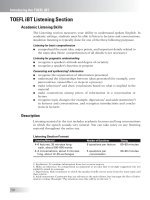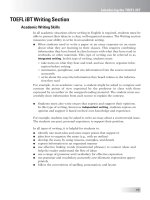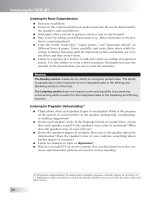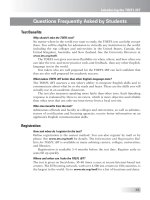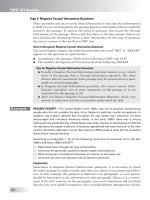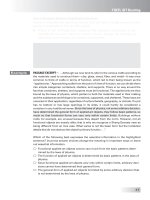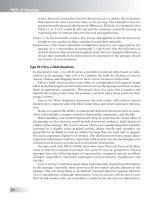The official guide to the toefl ibt third edition part 5 pps
Bạn đang xem bản rút gọn của tài liệu. Xem và tải ngay bản đầy đủ của tài liệu tại đây (267.68 KB, 7 trang )
TOEFL iBT Writing Section
Academic Writing Skills
In all academic situations where writing in English is required, students must be
able to present their ideas in a clear, well-organized manner. The Writing section
measures your ability to write in an academic setting.
b
Often students need to write a paper or an essay response on an exam
about what they are learning in their classes. This requires combining
information they have heard in class lectures with what they have read in
textbooks or other materials. This type of writing can be referred to as
integrated writing. In this type of writing, students must:
t
take notes on what they hear and read, and use them to organize infor-
mation before writing
t
summarize, paraphrase, and cite information from the source material
accurately
t
write about the ways the information they heard relates to the informa-
tion they read
For example, in an academic course, a student might be asked to compare and
contrast the points of view expressed by the professor in class with those
expressed by an author in the assigned reading material. The student must suc-
cessfully draw information from each source to explain the contrast.
b
Students must also write essays that express and support their opinions.
In this type of writing, known as
independent writing, students express an
opinion and support it based on their own knowledge and experience.
For example, students may be asked to write an essay about a controversial issue.
The students use past, personal experience to support their position.
In all types of writing, it is helpful for students to:
b
identify one main idea and some major points that support it
b
plan how to organize the essay (e.g., with an outline)
b
develop the essay by using reasons, examples, and details
b
express information in an organized manner
b
use effective linking words (transitional phrases) to connect ideas and
help the reader understand the flow of ideas
b
use a range of grammar and vocabulary for effective expression
b
use grammar and vocabulary accurately; use idiomatic expressions appro-
priately
b
follow the conventions of spelling, punctuation, and layout
19
Introducing the TOEFL iBT
Introducing the TOEFL iBT
Description
The total time for the Writing section is 50 minutes. Test takers write their
responses to two writing tasks (see the table below). Responses are typed into the
computer and sent to ETS’s Online Scoring Network where they are scored by
certified raters.
Writing Task Types
Task Type Task Description
Task 1: • Test takers read a short text of about 230–300 words (reading time, 3 minutes)
Integrated Writing Task on an academic topic.
Read/Listen/Write • Test takers may take notes on the reading passage.
• The reading passage disappears from the screen during the lecture that
follows. It reappears when test takers begin writing so they can refer to it
as they work.
• Test takers listen to a speaker discuss the same topic from a different
perspective. The listening passage is about 230–300 words long (listening
time, 2 minutes).
• The listening passage provides additional information that relates to points
made in the reading passage. Test takers may take notes on the listening
passage.
• Test takers write a summary in connected English prose of important points
made in the listening passage, and explain how these relate to the key points
of the reading passage. Suggested response length is 150–225 words; however,
there is no penalty for writing more as long as it is in response to the task
presented.
Task 2: • Test takers write an essay that states, explains, and supports their opinion
Independent Writing on an issue. An effective essay will usually contain a minimum of 300 words;
Writing from Experience however, test takers may write more if they wish.
and Knowledge • Test takers must support their opinions or choices rather than simply list
personal preferences or choices.
• Typical essay questions begin with statements such as:
—Do you agree or disagree with the following statement? Use reasons and
specific details to support your answer.
—Some people believe X. Other people believe Y. Which of these two positions
do you prefer/agree with? Give reasons and specific details.
NOTE: This is the same type of task on the computer-based TOEFL and the
Test of
Written English
™ (TWE
®
).
20
About Test Scores
Score Scales
The TOEFL iBT provides scores in four skill areas:
Listening 0–30
Reading 0–30
Speaking 0–30
Writing 0–30
Total Score 0–120
The total score is the sum of the four skill scores.
Rating of Speaking and Writing Responses
Speaking
Responses to all six Speaking tasks are digitally recorded and sent to ETS’s
Online Scoring Network. The responses from each test taker are scored by 3 to 6
different certified raters. The response for each task is rated on a scale from 0 to 4
according to Rubrics on pages 187–190. The average of all six ratings is converted
to a scaled score of 0 to 30.
Raters listen for the following features in test taker responses:
b
Delivery: How clear was the speech? Good responses are fluid and clear,
with good pronunciation, natural pacing, and natural-sounding intona-
tion patterns.
b
Language use: How effectively does the test taker use grammar and vocab-
ulary to convey ideas? Raters determine the test taker’s ability to control
both basic and more complex language structures, and use appropriate
vocabulary.
b
Topic development: How fully do test takers answer the question and how
coherently do they present their ideas? How well did the test taker syn-
thesize and summarize the information in the integrated tasks? Good
responses generally use all or most of the time allotted, and the relation-
ship between ideas and the progression from one idea to the next are clear
and easy to follow.
It is important to note that raters do not expect test takers’ responses to be
perfect. Even high-scoring responses may contain occasional errors and minor
problems in any of the three areas described above.
21
Introducing the TOEFL iBT
Introducing the TOEFL iBT
Writing
Responses to all writing tasks also are sent to ETS’s Online Scoring Network. The
responses are rated by 2 to 4 certified raters on a score scale of 0 to 5 according
to the Rubrics on pages 200–201 and 209–210. The average of the scores on the
two writing tasks is converted to a scaled score of 0 to 30.
b
The response to the integrated writing task is scored on the quality of
writing (organization, appropriate and precise use of grammar and vocab-
ulary) and the completeness and accuracy of the content.
b
The independent writing essay is scored on the overall quality of the
writing: development, organization, and appropriate and precise use of
grammar and vocabulary.
It is important to note that the raters recognize that the responses are first
drafts. They do not expect test takers to produce a well-researched, comprehen-
sive essay. For that reason, test takers can earn a high score with a response that
contains some errors.
Score Reports
The score reports now provide better information than ever about a student’s
readiness to participate and succeed in academic studies in an English-speaking
setting. Score reports include:
b
four skill scores
b
total score
Scores are reported online 15 business days after the test. Test takers can view
their scores online free of charge. Colleges, universities, and agencies can also
view scores online when examinees have selected them as a score recipient. Paper
copies of score reports will be mailed shortly after the scores are posted online.
Score reports also include performance feedback that indicates whether a test-
taker’s performance was high, medium, or low, and describes what test takers in
these score ranges know and can do with the English language. In the future, per-
formance feedback will also include suggestions for improvement.
Score Requirements
Each institution sets its own requirements for TOEFL iBT scores. Test takers
should consult their target institutions to determine their specific TOEFL iBT
score requirements. A list of colleges, universities, and agencies that accept
TOEFL scores and a list of institutional score requirements reported to ETS can
be obtained at
www.ets.org/toefl.
22
23
Introducing the TOEFL iBT
Sample TOEFL iBT Score Report
Introducing the TOEFL iBT
24
General Skill-building Tips
The best way for English-language learners to develop the skills measured by the
TOEFL iBT is to enroll in an English-language learning program that provides
instruction in:
b
reading, speaking, listening, and writing skills, with an emphasis on
speaking
b
integrated skills approach (e.g., instruction that builds skills in listening/
reading/speaking, listening/reading/writing)
In addition to the advice for improvement listed in Appendix 2 of this book,
ETS has created the following tips for students, but they also contain information
useful to teachers.
Reading Tips
English-language learners can improve their reading skills by reading regularly,
especially university textbooks or other materials that cover a variety of subject
areas (e.g., sciences, social sciences, arts, business, etc.) and are written in an
academic style. A wide variety of academic texts are available on the Internet as
well as in magazines and journals.
Reading to Find Information
b
Scan passages to find and highlight key facts (dates, numbers, terms) and
information.
b
Practice frequently to increase reading rate and fluency.
Reading for Basic Comprehension
b
Increase vocabulary. Flashcards can help.
b
Practice skimming a passage quickly to get a general impression of the
main idea instead of carefully reading each word and each sentence.
b
Develop the ability to skim quickly and identify major points.
b
After skimming a passage, read it again more carefully and write down
the main idea, major points, and important facts.
b
Choose some unfamiliar words in the passage and guess the meaning
from the context (surrounding sentences). Then, look them up to deter-
mine their meaning.
b
Underline all pronouns (e.g., he, him, they, them, etc.) and identify the
nouns to which they refer in the passage.
b
Practice making inferences and drawing conclusions based on what is
implied in the passage as a whole.
Practice your reading skills
with TOEFL
®
Practice Online at www.ets.org/toeflpractice and receive instant
scores to confirm you are ready for test day.
25
Introducing the TOEFL iBT
Notes
The Reading section does not measure summarizing skills, but practicing them
builds the skills required for the integrated tasks in the Speaking and Writing
sections.
Reading to Learn
b
Identify the passage type (e.g., cause/effect, compare/contrast, classifica-
tion, problem/solution, description, narration, etc.) and its organization.
b
Organize the information in the passage:
t
Create an outline of the passage to distinguish between major and
minor points.
t
If the passage categorizes information, create a chart and place the
information in appropriate categories.
On the TOEFL iBT, test takers do not have to create such a chart. Instead, a chart
with possible answer choices is provided for them, and they are required to fill
in the chart with the correct choices. Practicing this skill will help test takers
think about categorizing information and be able to do so with ease.
b
Create an oral or written summary of the passage using the charts and
outlines.
b
Paraphrase individual sentences in a passage. Then paraphrase entire
paragraphs.
Listening Tips
Listening to the English language frequently and reading a wide variety of aca-
demic materials is the best way to improve listening skills.
Watching movies and television and listening to the radio provide excellent
opportunities to build listening skills. Audiotapes and CDs of lectures and pre-
sentations are equally valuable and are available at libraries and bookstores.
Those with transcripts are particularly helpful. The Internet is also a great
resource for listening material (e.g.,
www.npr.org or www.bbc.co.uk/radio or
www.bbc.co.uk/worldservice/learningenglish).
